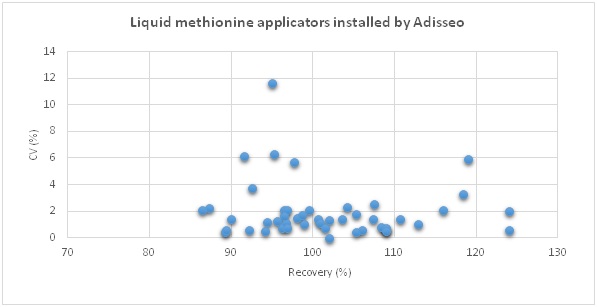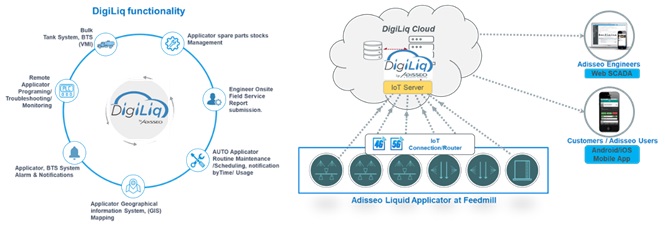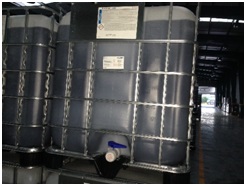Summary: Can liquid OH-Methionine be sprayed accurately and consistently into feed mixer? This article compiled 86 lab reports from 22 feed mills across 6 countries in the Asia Pacific region, the results showed both recovery and homogeneity are as reliable and consistent as dry form of methionine.
Liquid additives possess many advantages over dry form, such as automation, no human error, less packaging materials, reduced power consumption, no dust in working environment, more flexibility in formulation, better pellet quality, just name a few. In recent years, liquid feed additives are gaining popularity among feed producers, especially for those with large production capacity.
For poultry feeds, methionine is one of important additives, available in both powder and liquid forms. Comparing to its classical dry form DL-methionine, liquid form (OH-methionine) was specifically developed for its high efficiency in both methionine value and application. In addition to the advantages mentioned above, liquid users also enjoy significant cost saving. As such, we have seen a steady increase in the adoption of the liquid form. For the year 2020, it is estimated approximately one third of total methionine usage world-wide was OH-Methionine.
Spray accuracy and homogeneity
Spray recovery and homogeneity are two frequently used parameters to evaluate the liquid applicators. Recovery is normally expressed as the percentage of amount detected in feeds by lab analysis against the amount sprayed. Homogeneity, in another term, as expressed as coefficients of variations (CV), is to assess the spray consistency within the same batch or among batches.
In a recent project, we installed customized liquid applicators in two feedmills in Indonesia, spray recovery and homogeneity were evaluated by analyzing a series of feed samples in an independent laboratory, for both dry and liquid forms of methionine. The results (Table 1) showed average 98% recovery and CV <2% for both feedmills after switching from DL-Methionine to liquid OH-Methionine, and there are no differences in both parameters. The results confirm the liquid spray is as reliable and consistent as of its dry form.
| Feed sample | Feedmill 1, Indonesia | Feedmill 2, Indonesia | ||
| DL-Met, powder | OH-Met, liquid | DL-Met, powder | OH-Met, liquid | |
| A | 2.47 | 1.98 | 2.60 | 2.40 |
| B | 2.26 | 1.95 | 2.66 | 2.32 |
| C | 2.50 | 1.95 | 2.54 | 2.40 |
| D | 2.38 | 1.94 | 2.68 | 2.35 |
| Dosing target, kg/mt | 2.50 | 2.00 | 2.50 | 2.40 |
| Average recovery, kg/mt | 2.42 | 1.96 | 2.62 | 2.37 |
| Average recovery, % | 96.9 | 97.8 | 104.8 | 98.6 |
| Homogeneity, CV % | 4.5 | 0.9 | 2.4 | 1.7 |
In another study, we measured mixing homogeneity of both dry and liquid forms of methionine added into the same feed mixer in separate production batches. After mixing and pelleting, we collected 8 feed samples per batch, analyzed for methionine contents as well as contents of trace minerals zinc and copper as references. Both batches used the same trace minerals premix at the same dosage, so that the contents of zinc and copper were the same. The results in Table 2 show both methionine sources achieved full recovery, with CV 6.58% for dry and 5.50% for liquid. The mixing homogeneity is in good agreement with that of trace minerals Zn and Cu as both showed desirable low CV.
| DL-Met Feed | OH-Met Feed | ||||||
| Feed sample | DL-Met, g/kg | Zn, ppm | Cu, ppm | Feed sample | OH-Met, g/kg | Zn, ppm | Cu, ppm |
| B-1 | 1.80 | 108.9 | 23.1 | C-1 | 1.97 | 106.6 | 22.4 |
| B-2 | 1.60 | 105.2 | 21.0 | C-2 | 1.97 | 105.2 | 22.1 |
| B-3 | 1.80 | 108.2 | 23.0 | C-3 | 1.95 | 113.6 | 21.7 |
| B-4 | 1.70 | 104.6 | 20.7 | C-4 | 1.99 | 112.8 | 25.2 |
| B-5 | 1.80 | 103.0 | 21.5 | C-5 | 2.19 | 102.7 | 18.5 |
| B-6 | 1.50 | 100.6 | 20.4 | C-6 | 2.18 | 104.2 | 22.5 |
| B-7 | 1.70 | 104.2 | 19.7 | C-7 | 2.19 | 102.4 | 18.7 |
| B-8 | 1.80 | 112.2 | 22.7 | C-8 | 2.17 | 124.8 | 20.7 |
| Mean | 1.71 | 105.9 | 21.5 | 2.08 | 109.0 | 21.5 | |
| CV, % | 6.58 | 3.49 | 5.90 | 5.50 | 7.04 | 10.21 |
Industry survey on spray accuracy
Figure 1 shows the results of an industry-wide survey from Southeast Asia on OH-Methionine spray accuracy. Regardless which suppliers installed the spray applicators, the laboratory reports collected from the past two years revealed 88% of them recorded recovery rate above 90%, and 94% of the reports showed excellent homogeneity, with CV <10% (Figure 1).

Further looking at those liquid applicators installed and maintained by Adisseo, the spray performance was even better, with nearly 98% of them achieved recovery above 90%, and 98% of them delivered CV <10% (Figure 2). This superior performance was the result of comprehensive feedmill site survey followed by customized designing, by Adisseo engineer team, to ensure the tailored applicators best suit the needs of each feedmill’s situation and requirements.

Clearly, a dedicated team of liquid applicator specialists stations near the end users, can offer end users not only trouble-shooting any time, but also, quarterly maintenance program as well as structured training program for feedmill engineers, to ensure peace of mind in using OH-Methionine.
Moving towards digitalization
With current trend of digital transformation and process automation, it is possible to upgrade all engineering work to an integrated cloud platform (DigiLiq), which connects all liquid applicators and allows on-time fault detection, remote trouble shooting, and auto scheduling of maintenance, etc. (Figure 3). End users can enjoy additional peace of mind in that their liquid applicators are well taken care and serviced remotely with zero applicator downtime, especially during Covid-19 lockdown period.
Figure 3: Spray and maintenance automation (Digliq)

In conclusion, the extensive engineering work and lab analyses by far, have clearly demonstrated that the spray of liquid OH-methionine is as accurate and consistent as dry methionine into feed mixer. Tailored applicators with on-site maintenance can ensure desirable spray accuracy and homogeneity. Furthermore, the application and maintenance of liquid additives can be readily digitalized to offer extra peace of mind for end-users especially during difficult times.

IBC Packaging Rhodimet AT88 
Drum Packaging Rhodimet AT88 
Isotank Packaging Rhodimet AT88